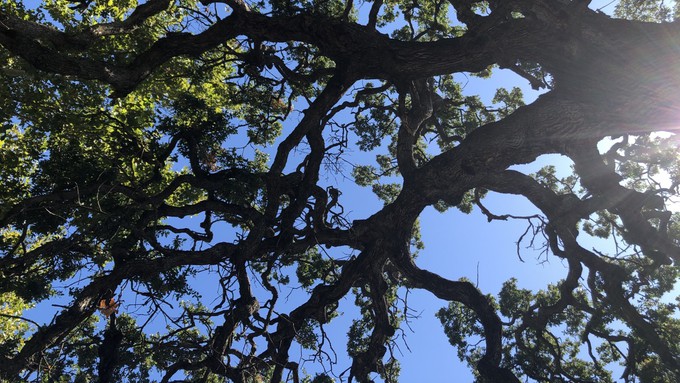
Also on tap: Guided tour of Capitol Park trees

Look up and learn! The Sacramento Tree Foundation offers free guided tours of Sacramento trees, including a June 3 tour of Hollywood Park via bicycle. Kathy Morrison
It’s time to appreciate the trees in the City of Trees. The Sacramento Tree Foundation offers some fun and informative opportunities to get better acquainted with our urban forest.
On Saturday, June 3, take a guided, tree-centric bike tour of Hollywood Park with SacTree experts.
“Join us for the annual Hollywood Park CommuniTree Bike Tour!” SacTree posted in its description of the event. “Grab your bike and join your neighbors in Hollywood Park to learn about our local trees and see different species in person. Afterwards, we’ll gather at Two Rivers Cider and support the local business.”
Check in at 11:30 a.m. Bring a bike helmet, sunscreen and water. The tour will reach Two Rivers about 1 p.m. Families with children are welcome.
This event is free but advance registration is a must. Sign up here: https://sactree.org/event/hollywood-park-bike-ride-tree-tour/.
This bike tour isn’t the only tree-friendly upcoming event hosted by SacTree. At 6 p.m. Thursday, May 25, take a guided walking tour of Capitol Park and meet the historic trees that call it home. Local arborists will lead this special 90-minute tour, noting the many important and significant trees that grow in this unique collection.
This tour is free but space is limited. Advance registration is a must and, at time of this writing, the foundation is taking names for a waiting list. After signing up, participants will receive an email with details including where to meet your guides. It’s a big park; Capitol Park stretches from 10th to 15th Street and L to N Street. To register: https://sactree.org/event/capitol-park-tree-tour/.
“Walk the grounds of our State Capitol with two of SacTree’s arborists and learn about the historic, unusual, and beautiful trees in the park,” say the organizers. “Did you know that Capitol Park has a tree who traveled as a seed aboard the space shuttle Apollo 14, and boasts many state and national champion largest trees?”
(Yes, those stately palms are the biggest of their kind.)
Home to several monuments as well as hundreds of trees, Capitol Park holds a special spot in state history. “In 1863, California Governor Leland Stanford envisioned a Victorian garden ‘with a beauty and luxuriousness that no other capitol can boast’ surrounding the California State Capitol,” says its official website. “Well over a century and a half later, California’s Capitol Park has a luxuriousness and beauty that few capitols can compete with.”
Among the early groves in Capitol Park were saplings from 40 Civil War battlefields as a memorial to California’s veterans. Now, the 40-acre park spans 12 city blocks and features trees and plants from almost every continent, including several endangered species.
More details on upcoming Sacramento Tree Foundation events: https://sactree.org/.
Comments
0 comments have been posted.Sacramento Digs Gardening to your inbox.
Food in My Back Yard Series
May 6: Maintain soil moisture with mulch for garden success
April 29: What's (already) wrong with my tomato plants?
April 22: Should you stock up on fertilizer? (Yes!)
April 15: Grow culinary herbs in containers
April 8: When to plant summer vegetables
April 1: Don't be fooled by these garden myths
March 25: Fertilizer tips: How to 'feed' your vegetables for healthy growth
March 18: Time to give vegetable seedlings some more space
March 11: Ways to win the fight against weeds
March 4: Potatoes from the garden
Feb. 25: Plant a fruit tree now -- for later
Feb. 18: How to squeeze more food into less space
Feb. 11: When to plant? Consider staggering your transplants
Feb. 4: Starting in seed starting
Sites We Like
Garden Checklist for week of May 11
Make the most of the lower temperatures early in the week. We’ll be back in the 80s by Thursday.
* Plant, plant, plant! It’s prime planting season in the Sacramento area. Time to set out those tomato transplants along with peppers and eggplants. Pinch off any flowers on new transplants to make them concentrate on establishing roots instead of setting premature fruit.
* Direct-seed melons, cucumbers, summer squash, corn, radishes, pumpkins and annual herbs such as basil.
* Harvest cabbage, lettuce, peas and green onions.
* In the flower garden, direct-seed sunflowers, cosmos, salvia, zinnias, marigolds, celosia and asters. (You also can transplant seedlings for many of the same flowers.)
* Plant dahlia tubers.
* Transplant petunias, marigolds and perennial flowers such as astilbe, columbine, coneflowers, coreopsis, dahlias, rudbeckia and verbena.
* Keep an eye out for slugs, snails, earwigs and aphids that want to dine on tender new growth.
* Feed summer bloomers with a balanced fertilizer.
* For continued bloom, cut off spent flowers on roses as well as other flowering plants.
* Add mulch to the garden to maintain moisture. Mulch also cuts down on weeds. But don’t let it mound around the stems or trunks of trees or shrubs. Leave about a 6-inch-to-1-foot circle to avoid crown rot or other problems.
* Remember to weed! Pull those nasties before they set seed.
* Water early in the day and keep seedlings evenly moist.